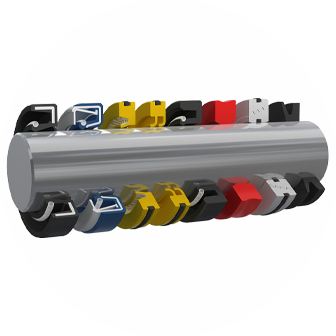
Where there is movement there are Lip Seals
Lip seals are used in a wide range of applications and are mounted on pistons or cylinders. The main function is to prevent access to contaminating particles and to keep lubricants within the application. To choose the appropriate sealing solution, several factors must be taken into consideration, such as: the operating temperature, the contact fluids, the pressure, the stroke length and the sector of application. All these factors will allow you to correctly identify the type of elastomer to use.

What to choose and when to change
SET DE-DEM
DE - DEM seals have a standard hardness of 75 ShA, which allows for easier assembly. It is the outer lip that performs the dynamic sealing function and its use is recommended for pressures up to 80 bar/cm2. The main application is carried out between the piston and the jacket or between the stem and the head. The sizes of the DE type lip seals are expressed in inches, while for the DEM type they are in millimeters. They are commercially available in NBR or FPM compounds.
SET U-UM
U - UM seals have a standard hardness of 90 ShA. They can be used indifferently for sealing on piston or cylinder, with pressures up to 120 bar / cm2. These gaskets are used on reciprocating reciprocating mechanical parts, such as pistons. The main application is between piston and rod. The sizes of the U type lip seals are expressed in inches, while for the UM type they are in millimeters. They are commercially available in NBR or FPM compounds.
SET DI-DIM
DI - DIM gaskets have a standard hardness of 90 ShA, which allows a more solid assembly. The dynamic seal of the gasket is made by the inner lip and its use is recommended for pressures up to 120 bar/cm2. The main application is carried out between the piston and the jacket or between the stem and the head. The sizes of the lip seals type DI are expressed in inches, while for the type DIM they are in millimeters. They are commercially available in NBR or FPM compounds.
TO CHOOSE
The choice of the material to be used is fundamental to prevent rapid wear and malfunction of the sealing system. The gasket must be replaced when it has cracks as it cannot guarantee optimal operation.






